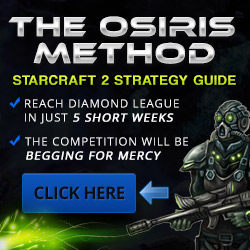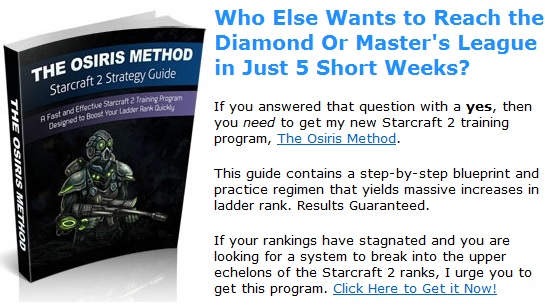Best Starcraft 2 Zerg Army CompositionsHome --> Zerg Guide --> Zerg Army Compositions (you are here)
Furthermore, good Zerg players rarely use a single unit combination throughout the course of a game but rather change regularly based on the game's current situation. Certain army compositions may only be viable at certain times in the game and the Zerg player needs to be able to take advantage of that fact. For example, imagine a Zerg player using Brood Lords and Corruptors against a Terran. The Terran player is likely to add on as many Vikings as they can to stop this air assault. Rather than continue to produce Corruptors and Brood Lords, the Zerg player may stop entirely and abruptly switch over to mass Zerglings. Under normal circumstances, mass Zerglings are easy to stop, but the surprise of the transition may catch the Terran off guard and result in a win for the Zerg. While Zerg players should be flexible in their unit choices, there are a few particularly effective Starcraft 2 Zerg army compositions and unit combinations. Below, we will go over these effective combinations and what races they do best against. Mass Roaches One of the best Zerg army compositions is actually mass Roaches. This combination is particularly effective in the early to mid game. Before the Zerg is maxed, each Roach provides a massive amount of health, a moderate amount of DPS, and costs very little resources. It is easy for a Zerg player to pick up a 50-60 supply lead just by quickly building up an army of 30-40 Roaches. Roaches themselves only cost 25 vespene gas a piece, which makes producing them in large quantities early in the game viable. Early in the game, a "Roach Bust" or a Roach rush of just 7-9 Roaches is very effective against any race when the opponent has tried to go for too early of a third base. Terran players in particularly are susceptible to this early Roach pressure if they add on a macro CC before their Factory. Once players max out, Roaches become much less effective. Roaches cost 2 supplies, which is relatively high compared to their strength and cost. Roaches are still good however in the late game after an army trade. If two maxed armies battle, the Zerg player can re-macro quickly with a wave of Roaches. Roaches and Hydralisks Often referred to as "Roach Hydra", this is the natural transition from mass Roaches in the mid to late game. While mass Roach is great in the early to mid game, towards the end of the mid game and into the late game, Roaches alone are not a great unit choice. Not only do Roaches not deal enough damage for their supply cost, but they also cannot hit air units. Hydralisks take care of the Roach weaknesses. Hydralisks have almost double the DPS of the Roach (14.5 for the Hydralisks to 8 for the Roach). Hydralisks also have a longer range and can hit air units. Why not just mass Hydralisks? Hydralisks are noticeably more expensive than Roaches and have much less health than Roaches. It is much more efficient for the Roaches to sit in front and soak up damage while the Hydralisks sit safely in the back and dish out the damage. Late in the game, Vipers are added to this Zerg army composition for the Abduct and Blinding Cloud ability. Abduct is used to pull long-range units like the Colossus into the middle of the Roach/Hydralisk ball while Blinding Cloud is used to shut down enemy Siege Tanks. Siege Tanks are a strong counter to Roaches and Hydralisks. Blinding Cloud completely neutralizes the Siege tank. Zerglings and Mutalisks Zerglings and Mutalisks are the fastest Zerg army composition. This army composition is generally not intended to attack enemy forces directly, but instead uses its speed and mobility to harass the enemy's bases, control the map, keep the enemy pinned inside their base, and snipe expansions. If this harass is kept up long enough, the Zerg player is free to claim a multiple expansion lead, ultimately winning the game after overwhelming the enemy by sheer force. Zerglings pair well with Mutalisks since Zerglings cost no gas whereas Mutalisks cost a lot of gas. Even if you wanted to go for mass Mutalisks, you should get a lot of Zerglings anyway just because you will otherwise have extra minerals. In this composition, Zerglings are very expendable, whereas Mutalisks are not. Losing 20+ Zerglings in an attack is perfectly acceptable, whereas even losing a single Mutalisk hurts. Vespene gas is the limiting resource when using mass Mutalisks, so try to keep them all alive. Against Terran players using Marines, Banelings are also included in the mix. Banelings are used to destroy Marines as Marines with Medivac support are good against both Mutalisks and Zerglings. Remember that Banelings cost vespene gas and for every 4 Banelings you make, there will be 1 less Mutalisk in your army. Only make Banelings if you need them and make sure you get a lot of damage out of each Baneling hit. Banelings work much better when used on creep (for the movement speed bonus) and after researching Centrifugal Hooks (+Baneling movement speed). Swarm Hosts Swarm Hosts, a Heart of the Swarm unit, can be used in large quantities without many other (if any) units for support. A Zerg player typically does not make only a couple Swarm Hosts. The size of the Swarm Host army needs to be significant as Locusts do not have a very long range. If you only have a couple Swarm Hosts, ranged enemy units will take down the Locusts before they ever get a shot off. Zerg players using Swarm Hosts typically need to tie up at least 40-50% of their army supply in Swarm Hosts for the Swarm Hosts to be effective. Even though Swarm Hosts cannot hit air units, sometimes they are used against air armies. Zerg players can build creep footholds outside the opponent's base (either by spreading creep across the map or by using Overlords to get it started then having Queens drop Creep Tumors). On the creep foothold, Spore Crawlers can be built in large quantities. Queens can be used as additional anti-air and to help heal damaged Spore Crawlers (or each other). Vipers can be added to pull in any long-range air units like the Tempest that might try to outrange these fortifications. Swarm Hosts and Infestors The Infestor is a good support unit for the Swarm Host. Enemy units hit by Fungal Growth are rooted in place and cannot run away from the Swarm Host's Locusts. Zerg players using Swarm Hosts will also likely have plenty of excess minerals, which can be dumped into Zerglings or even Roaches. To help make the Infestor and Swarm Host combination more stable, a lot of defensive structures and a lot of bases are necessary. Swarm Hosts can siege the enemy's fourth or fifth base safely from the confines of the Zerg creep. Infestors can stay within the safety of Spores and Spines while they regenerate energy. You can then push out and make an attack when your Infestors hit 200/200 energy. Locusts plus 8 Infested Terrans per Infestor can be a really formidable force! Ultralisks and Queens Ultralisks are a powerful late-game unit that do a ridiculous amount of damage, have huge HP pools. Due to this strength, Ultralisks are very expensive. Each Ultralisk costs enough resources that you will want to micro them individually to make sure you do not lose a single one. Pull each one out of battle as they get low HP so they can heal up and fight another day. One unusual but very effective support unit for the Ultralisk is the Queen. While Queens can provide light anti-air support against things like Void Rays, their real function here is to use Transfusion. Transfusion works well with Ultralisks in the late game because Ultralisks have so much health. It is very easy to heal an Ultralisk and get the full healing power of Transfusion. Additionally, late in the game, Queens should have a lot of energy. This means they will be able to use Transfusion up to 4 times each before running out of energy. Ultralisks pair well with just about any army. They can be used as a tank for lighter high DPS units like the Hydralisk or even to destroy tough buildings like the Planetary Fortress (PF). One good strategy for taking down PFs is to use 2 Ultralisks to attack them, and when the enemy gathers with SCVs to repair, roll in with a couple Banelings to destroy the clumped up SCVs. Works like a charm! Infestors Any of the previous Zerg units and unit combinations tends to pair well with the Infestor. Mass Infestors have fallen out of favor after the Fungal Growth nerf, but they are still useful. These days, players usually add on a couple to whatever their current army combination is in order to use Fungal Growth. Fungal Growth's DPS is solid. A good Fungal Growth can snag 10-20 units. At 30 damage over 4 seconds, an Infestor that catches 20 units in a single Fungal Growth will be deal 600 damage over 4 seconds (or 150 DPS a second)! Late in the game when resources are tight, a pack of 6-8 Infestors can work well. After banking up full energy pools, a half dozen Infestors can burrow, sneak across the map, and use all their energy on Spawn Infested Terran to take down an enemy's expansion plus all its harvesters. Corruptors and Brood Lords If you have paid any attention to our Zerg unit counters page, you know that the Brood Lord hard counters about half of the ground units in Starcraft 2 and soft counters the rest of those ground units. Brood Lords are unstoppable versus all manner of ground-based armies. The weakness of the Brood Lord is that it is very slow and cannot hit enemy air units. Corruptors are good versus most enemy air units (and good against all of them when there are more Corruptors than enemy air units). Corruptors cannot hit ground units. As a result, it is natural to pair Brood Lords with Corruptors as Brood Lords take down enemy ground units and Corruptors take down enemy air units. This army composition works best as a surprise or a transition. A common and very effective Zerg strategy is for the Zerg player to switch to air units after using an initial army of Roaches, Zerglings, Swarm Hosts, and/or Hydralisks. For example, the Zerg player uses Zerglings and Roaches in large quantities against the Terran player. The Terran player responds by adding on Thors, Siege Tanks, and Hellbats. The Zerg could keep up their assault while banking up vespene gas. Once the Zerg player hits 2500 gas banked and a Hive, they could suddenly swap to making 20 Corruptors. As the Corruptors are being produced, more gas would be accrued. Once another 1000 gas was mined, the Zerg could morph 10 of those Corruptors into Brood Lords and immediately go on the offense. With the sudden appearance of 10 Brood Lords, the mech army would not stand a chance. With 10 Corruptors to stop Vikings, the Terran player would not be able to get to the Brood Lords. Conclusion While these Zerg army compositions are a good place to start, the Zerg player needs to be flexible in their unit choice. Do not be afraid to mass up on one particular unit if it makes sense in the context of your current game. |
Don't be shy - share this page on G+ and Twitter!
Sign up for my Free Starcraft 2 Mini-Course where I reveal my best strategies not seen anywhere on this site!
Starcraft 2 Strategy Guide Privacy Policy Contact Us Disclaimer
©2013 www.osirissc2guide.com

